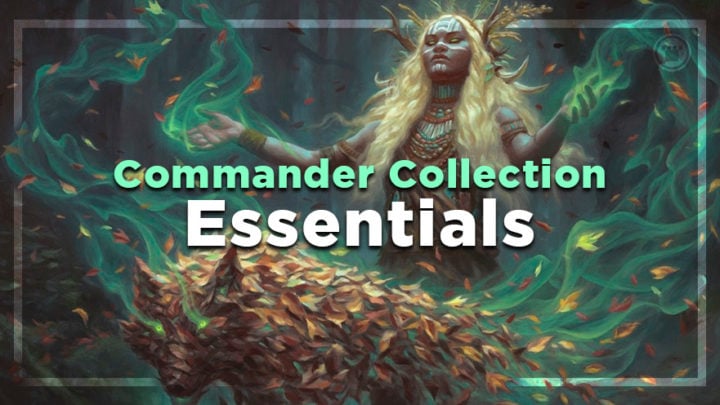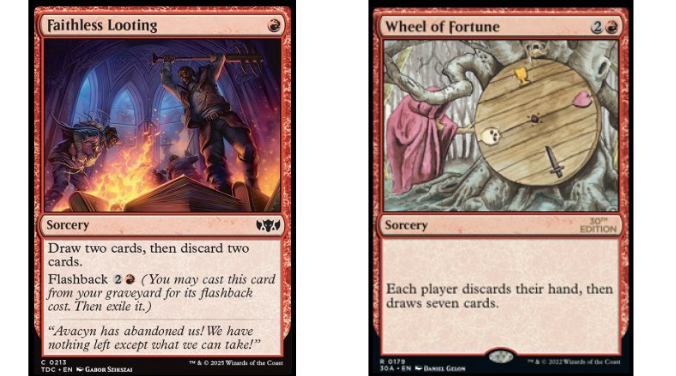When you first get into Commander, the format can be extremely overwhelming. Aside from the sheer volume of different commanders available, the number of playable cards feels innumerable. Some cards see more play than most, however, due to their universal usefulness. There are even a few that are so prominent, some players would go so far as to call them “auto-includes” in their colors. While I’m not one to advocate for sticking to the staples, there are some cards that every Commander player’s collection should have.
I’ll cover some of these cards today, focusing on the most emblematic effects in each color. In the case of more expensive cards, I’ll also include affordable options to make building up your Commander collection easy and accessible, especially for newer players.
White
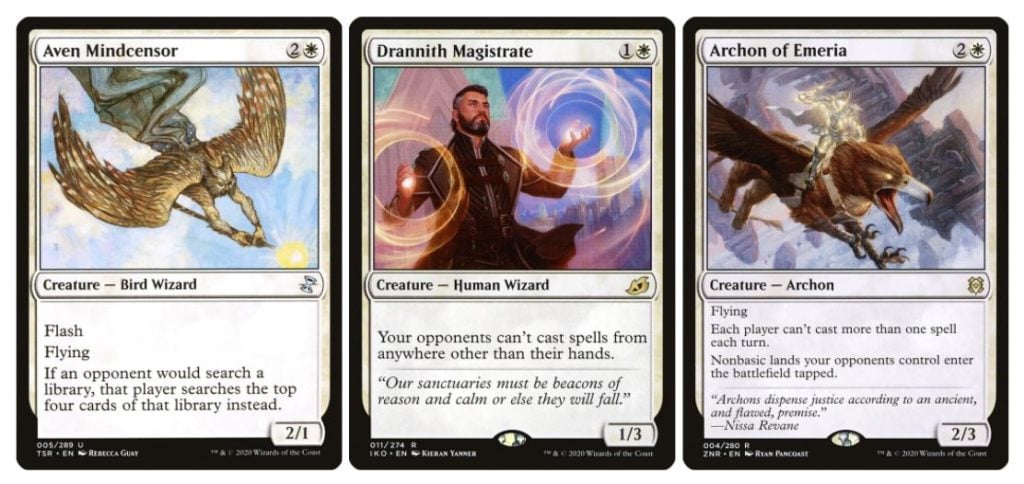
White is a very egalitarian color, one that often seeks for players to operate on a level playing field. Rather than accelerate itself to keep up with the table, white seeks to slow other colors down to match its pace.
White is well-known for its “hatebears”: creatures that impose a form of penalty or restriction on players, to ensure they can’t get too out of control. Aven Mindcensor is one of the most popular, as it dramatically reduces the effectiveness of search effects, most notably tutors and green ramp spells.
Drannith Magistrate is a more recent addition to the hatebear ranks, but it can shut down a myriad of spells and archetypes. Not only does it prevent the likes of flashback and foretell, but it stops opponents from even casting their commander! This is often enough to stop some decks in their tracks, at least until they find a way to deal with this tricky Wizard.
Archon of Emeria is the newest hatebear on the block, and one of the most potent. Commander is full of nonbasic lands, so it’ll regularly force opponents to play a whole turn slower by having them enter tapped. In addition to that, being restricted to casting one spell a turn is backbreaking for some decks like Storm.
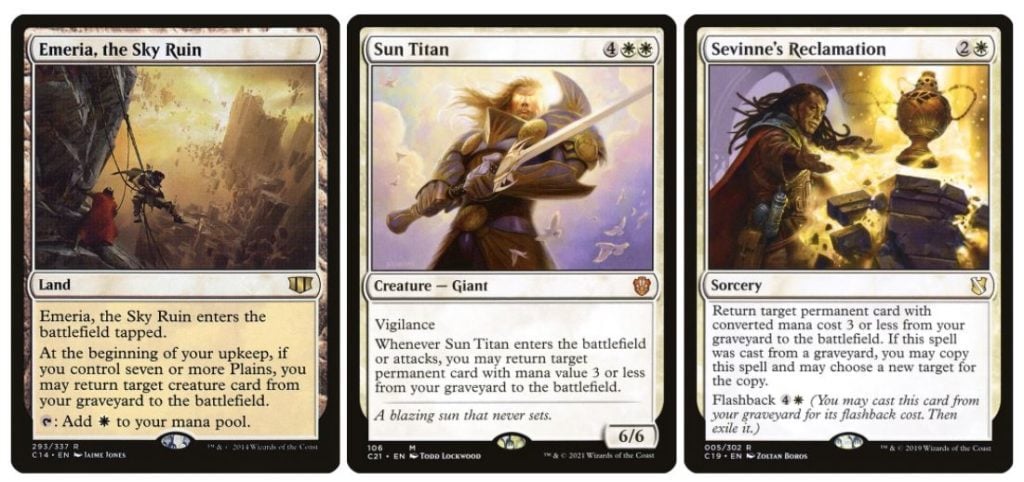
White is also exceptional at returning permanents from the graveyard to play. This recursive effect is critical for any white deck to accrue value and keep up with the rest of the table.
Emeria, the Sky Ruin is one of the simplest and most powerful recursion cards in white’s toolbox. It rewards you for playing lands, and bringing back a creature every turn is an incredible incentive to play Plains. When you consider that lands can’t be countered and they’re rarely removed from play, Emeria should regularly pay dividends.
Sun Titan is a classic staple of the format, and it’s still an impressive and powerful card. It benefits you immediately thanks to its enter the battlefield ability, and it keeps rewarding you for every combat step where it gets into the red zone.
Sevinne’s Reclamation is another spell that returns permanents to the battlefield. It’s more transient than Sun Titan, but it’s more efficient and the flashback mode can even double your value. Unlike Emeria, Sevinne’s Reclamation and Sun Titan can return any permanent, so if someone happens to destroy your Emeria with a Ghost Quarter, you can get it back with these!
Blue
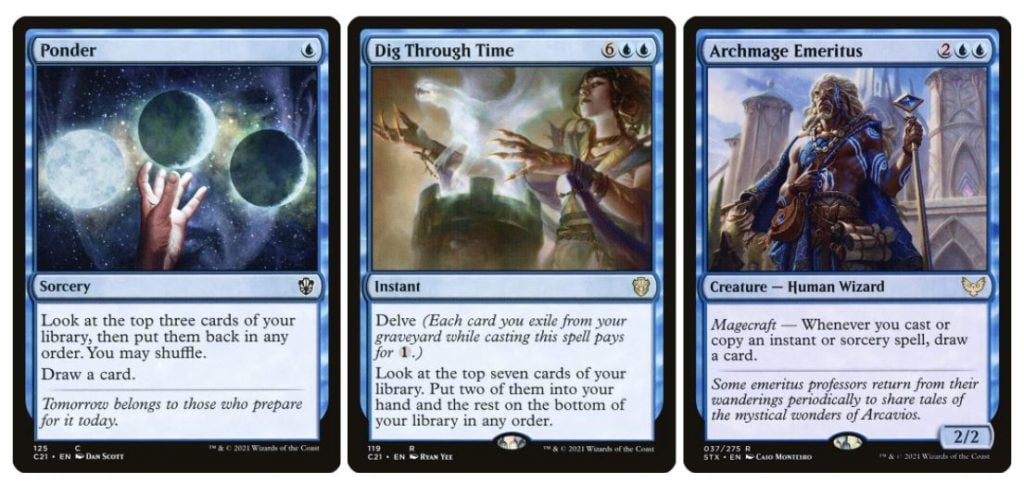
Blue is the color of information, which manifests itself in card draw and manipulation. Blue is the most universally powerful color when it comes to drawing cards, and it can help give decks longevity and consistency.
Cantrips are the bread and butter of blue. There’s been some debate over what exactly defines a “cantrip,” but a relatively safe definition is “an instant or sorcery that draws one card and costs one mana.” These greatly increase consistency when several are present in a deck. Ponder is one of the most famous cantrips, though there are dozens available; Preordain, Serum Visions, Opt, Consider, and Thought Scour are just a few more that fulfil a similar role in a deck, and you’ll usually want multiple.
There are many powerful card draw spells available in blue, with Dig Through Time being one of the more popular ones. This spell mixes blue’s exceptional card selection with the ability to draw several cards, and can comfortably fit into most blue decks.
Blue also has several permanents that can grant you a steady stream of cards. Rhystic Study is the most famous of these, but it has developed a bit of a reputation among players for being tedious and frustrating. I personally recommend Archmage Emeritus as a more enjoyable alternative; it doesn’t require you to keep track of what other players are doing, and it doesn’t make others feel restricted. Most blue decks run a high enough number of instants and sorceries, so triggering its magecraft ability shouldn’t be difficult.
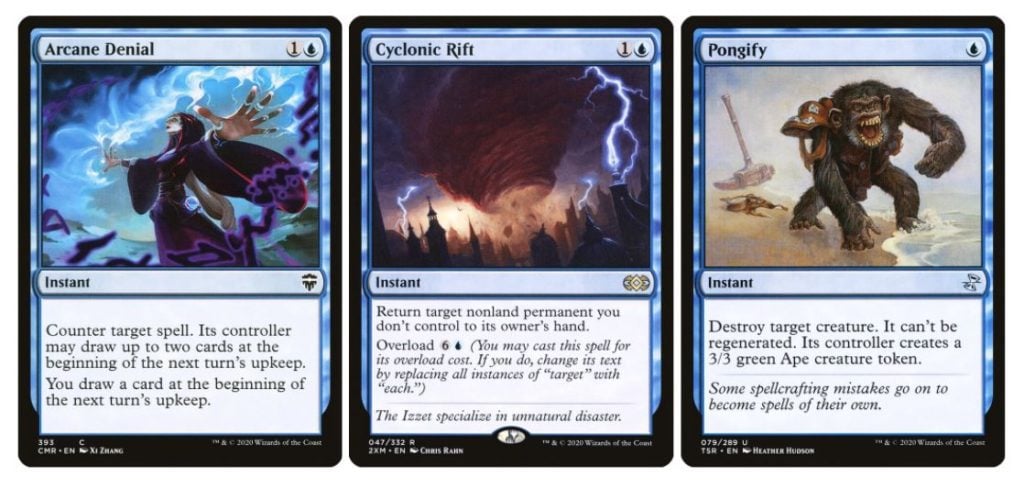
Blue is also one of the most interactive colors, and most blue decks will have at least one answer ready to go when things go sour.
Counterspells are arguably the most (in)famous kind of card in Magic, and you’ll find almost all of them in blue. While Counterspell is the most well-known, I’d recommend Arcane Denial as the “must-include” counter. It performs the same role, but giving your opponent two cards in exchange for countering their spell will make them less likely to attack you.
One of the most popular ways to deal with permanents in blue is bounce spells: cards that return permanents to their owner’s hands. Cyclonic Rift is the most popular, but can often leave players feeling salty, particularly if you cast it on their end step. It’s also a little pricey, but you can check out my article on the best budget versions of Commander staples for some more affordable alternatives.
Blue is also great at “replacing” creatures. Most of the removal available in blue either destroys or exiles the creature, but it leaves a more manageable creature in its place. Pongify is the perfect example of this; a 3/3 green Ape is nothing big in a 40 life format like Commander, so it’s a fine trade for removing a commander or important combo piece!
Black
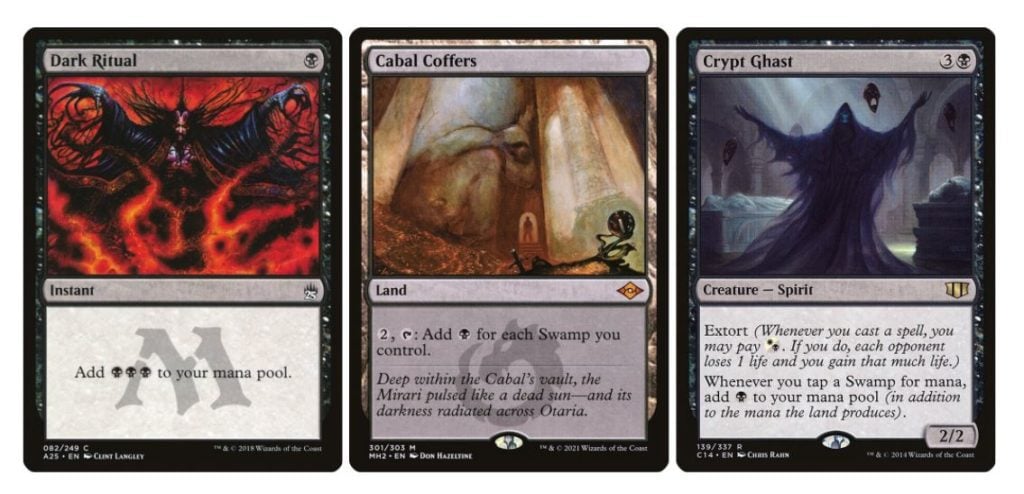
Many see black as the color that embodies “greatness, at any cost” (the flavor text on Dark Confidant). In Commander, black can generate a lot of mana in exchange for a heavy commitment to the color. A lot of powerful black cards can be very mana intensive, and powering them out a turn or two early can be really worth it.
Dark Ritual was the first mana-generating spell of its kind, and the reason why we call these spells “rituals.” It’s emblematic of black’s ability to exchange one resource for another, in this case trading a card for a burst of mana. While there are several other ritual effects in black (like Cabal Ritual), Dark Ritual is still often the best.
Cabal Coffers is the ideal example of black rewarding you for a heavy commitment to the color. The more Swamps you have, the more mana it generates. It’s a very sought after effect, and almost every mono-black deck can benefit from it. If the price is a little on the high side, you can always go for a Cabal Stronghold instead; it’s not quite as good, but it’s still impressive.
Another mana acceleration option in black is Crypt Ghast. Its mana-doubling ability is so powerful that it often becomes the target of the table as soon as it hits the board. Its extort ability is also a great way to make use of any excess mana it generates, making it both an enabler and a payoff at the same time. It’s about as critical to unlocking black’s full potential as Cabal Coffers is, perhaps even a little bit more!
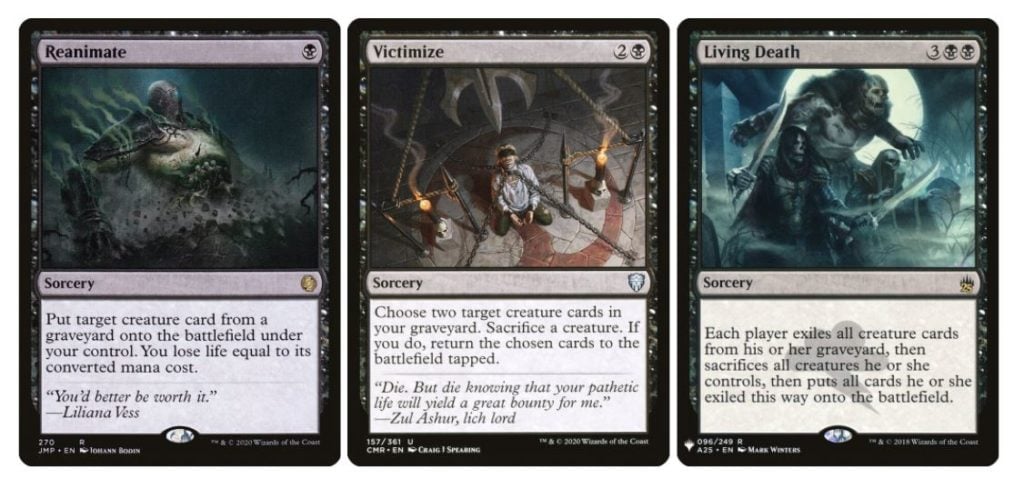
Black is often seen as the antithesis to white in the color pie, but they have some things in common. While white brings back permanents from the graveyard, black deals exclusively with creatures; it has much more of a sinister feel than its white counterparts, often requiring a sacrifice.
Reanimate is one of the original reanimation spells, and is more powerful now than ever before. While most cards can only bring back creatures from your graveyard, Reanimate breaks the mold and lets you swipe a creature from anyone’s bin! This can lead to a number of interesting lines and variation between games. In exchange for this powerful effect, you have to lose life equal to the mana value of the creature, but it’s almost always a price worth paying.
Victimize is another reanimator spell that requires a sacrifice, only this time it’s a bit more literal. In exchange for one of your creatures, you get to bring back two from your graveyard. Black often deals in sacrificing creatures for benefit, anyway, so it’s rarely a downside!
If you’re in black, you’re often playing heavily with the graveyard. Living Death very regularly acts as both a board wipe, as well as a hyper-efficient way to reanimate creatures en masse. It does give opponents any creatures they have in their graveyards, but you’re all but guaranteed to benefit the most from it. This is one of the easiest ways to pull ahead in a game, and I can’t recommend it enough.
(If you want further reading about reanimation and graveyard-based strategies, my piece on how every Commander deck can use the graveyard is essential reading!)
Red
Everything about red is fast. Between hasty creatures, quick card filtering, and direct damage, red wants to execute its game plan as quickly as possible. Red often does all this at the expense of card advantage, so it’s not unusual for red players’ hands to be the smallest at the table. If they’re allowed to drag race ahead of everyone uncontested, though, it often won’t matter, as the game will be all but finished!
When I think of card draw in red, Faithless Looting is the first thing that comes to mind. It doesn’t leave you with more cards in hand (in fact, it leaves you with one fewer), but you get to see so many cards for a single red mana. The flashback is great to give you something to do when you’re down to the last few cards in hand, too. Most red decks run this, and rightly so.
Wheel of Fortune is one of the most potent cards ever printed, and is extremely popular in Commander. Three mana to draw a fresh seven cards is absurd, though it comes with the drawback of providing the same for your opponents. It’s also extremely pricey, but you can find some more affordable options here.
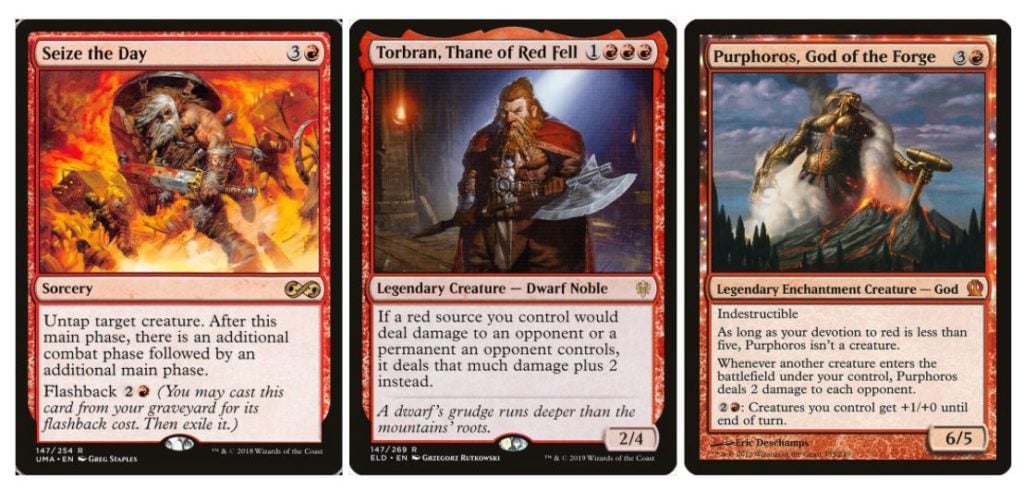
Keeping with red’s theme of speed, there are a number of ways to speed up your clock and close out the game in record time.
One of red’s most potent tools is the ability to grant extra combat steps. Cards like Seize the Day are perfect for more creature-focused decks to end the game. While blue is often known for taking extra turns, red doesn’t need a whole extra turn — just a few extra attacks will often do it!
Increasing damage is another of red’s ways to showcase its aggression. Torbran, Thane of Red Fell is not only a damage booster, but a great option as a fiery mono-red commander. These kinds of effects turn smaller creatures, burn spells, and continuous effects like Sulfuric Vortex into extremely potent threats. If Torbran is left unchecked for just a couple of turns, there often won’t be a game left to play!
As red can be quite creature-focused, value-based additional damage is another excellent tool to add to your collection. Purphoros, God of the Forge is the quintessential card for this effect. As creatures enter the battlefield, Purphoros hurls damage at your opponents, guaranteeing that they all provide at least some value for you. There are a few other effects like this, like Impact Tremors and Warstorm Surge, if you’re looking for redundancy.
Green
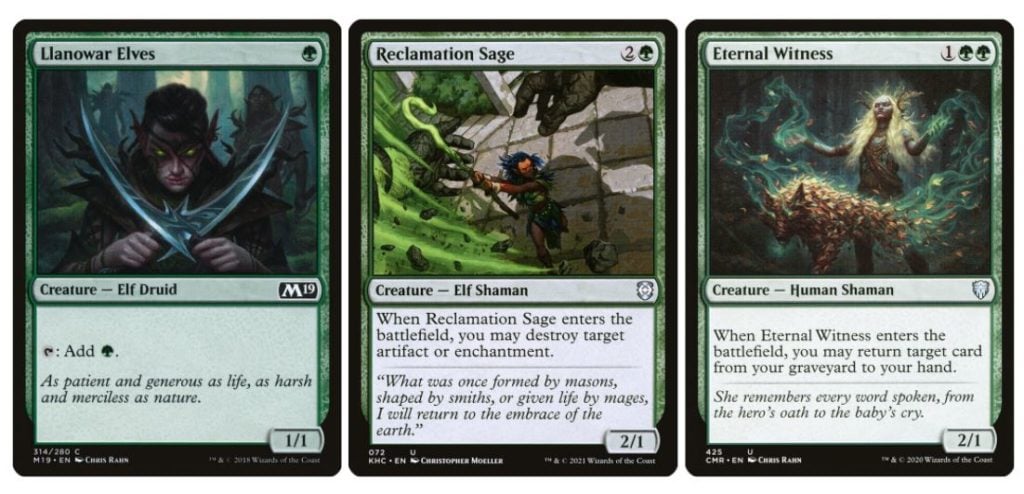
Green puts the natural ahead of everything else, and creatures are the most natural card type in Magic. Almost everything that green does revolves around creatures, so you’ll want to load up on creatures that can act as spells.
If you want to accelerate in green, you have two main options: land ramp and creature ramp. While some decks will rely on spells like Rampant Growth for land ramp, it’s very common for green-heavy decks to focus on mana dorks like Llanowar Elves for ramp. They’re often more efficient than land-based acceleration, and they can also attack! There are several options available, like Arbor Elf or Elvish Mystic, but Llanowar Elves is the blueprint from which all others were based.
Green has a built-in hate of the unnatural, so artifacts and enchantments are what it can deal with the best. Many decks can run spells like Naturalize, but most (particularly creature-focused ones) would sooner reach for Reclamation Sage. It’s efficient, and it can provide another body on the board to attack and block.
Unlike white and black, green doesn’t return cards from the graveyard to play. However, it is the best color for getting cards from your graveyard to your hand, and Eternal Witness is one of the best versions of this effect. Regrowth may have come first, but I’m sure you’re sensing a theme with these cards by now: it’s often better when it’s stapled to a creature!
Sure, it’s great to be able to leave a small body behind once you’ve gotten the use out of its effect, but how does green make better use of this than other colors?
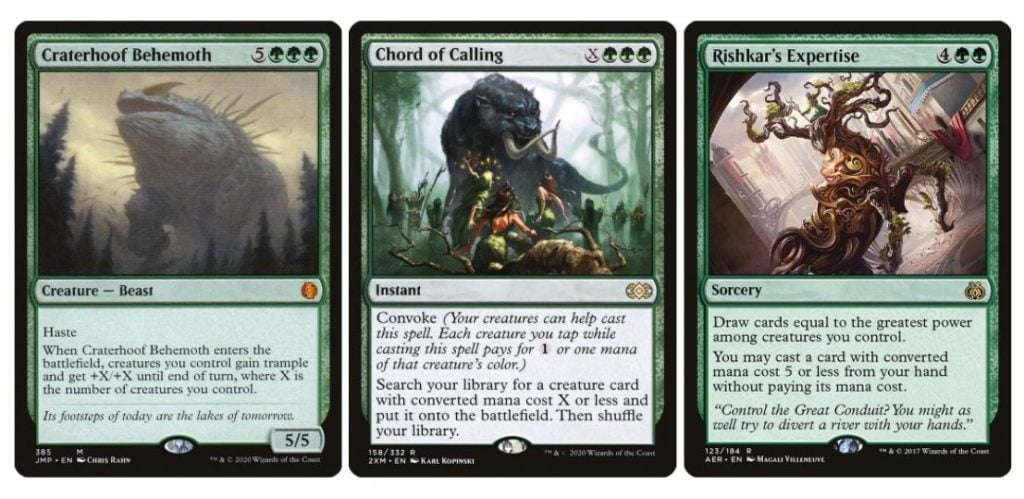
Green cares so much about having bodies on the board because its most powerful payoffs reward you for playing creatures. The more creatures you have, the better the effects will be!
The classic win condition in green is Craterhoof Behemoth. This is exactly why those extra little creatures matter: the more there are, the bigger they get! This is often the “I win the game” card in green, though it can be very costly. If Craterhoof is out of your price range, there are plenty of alternatives. Earthshaker Giant, End-Raze Forerunners, and even a simple Overrun can do an admirable job, and they will still often end the game on the spot.
Keeping with the high creature density theme, cards like Chord of Calling are ideal for green decks. Not only will your leftover creatures help pay for the convoke cost, but you’ll have more tutor targets to choose from if you build with cards like this in mind.
Another axis that green decks tend to operate well on is going tall. Thankfully, green is full of enormous creatures, and one of the best ways to make the most from them is Rishkar’s Expertise. Drawing cards equal to your biggest creature’s power will let you keep up with blue’s card draw, but then being able to cast a card from your hand with a mana value of five or less is absurd. This is a must-include in any deck that plays a decent number of large threats.
This is just the tip of the iceberg when it comes to staples in Commander, which is by itself just the tip of the format’s expansive card pool. If you’re looking for a more in-depth look at different types of cards and how to choose the right ones for your deck, we’ll be publishing more articles like this one in the future, so keep an eye out! You can also take a look at Anatomy of a Commander Deck: Eloise, Nephalia Sleuth for inspiration, and some insight into how I build a deck.
Are you new to Magic and want more content teaching you about the game? Sign-up for our emails and we’ll make sure you’re in the know about new content!

Scott is an Irish content creator and the Head of Budget Magic for the Izzet League. He focuses on affordable decks in Pioneer, Modern, and Pauper, particularly ones that stray from the mainstream. When he’s not writing about his favorite decks, he can be found talking incessantly about them on Twitter and on The Budget Magic Cast.

